| We are very excited that, after years of hoping to find some kin of Lt. Wallace, who lost his life saving his crew, one last effort in fall 2015 has allowed us to get to know his daughter, Judy, and she has been gracious to share with us much about her biological father, whom she never met. She made a trip to China and Yunnan, where her father was lost, in the spring of 2016. See a bit more here. |
(Early crew photo above courtesy of the family of James Vaughn. For unexplained reasons, only eight of the crew went on this particular mission. Not pictured from that flight: Martin Archer.)
Honoring A Common Hero: 2nd Lt. William H. Wallace
(Written by Patrick Lucas, March 6, 2006)
Hollywood’s Imagined Heroes Have Never Come Close
On a late afternoon in June, 1944, a single American B-24 bomber struggled up into cloudy skies from one of the runways at the Guilin (Kweilin) air base in southern China, then banked to the northeast and set a course towards the Changjiang (Yangtze) river. Orders for the pilot, 2nd Lt. William H. Wallace (308th Bombardment Group, 425th Squadron), and his crew of seven others, were for this lone aircraft to search out Japanese shipping on a predetermined stretch of the Yangtze, and if shipping was sighted, to do those ships all possible harm with the nine 500 pound bombs that the bomber carried. All this to be done by one, thin, aluminum-shelled craft with only eight men inside.
Nearing the start point for their run over the river, in the near darkness at 10 pm, only a thin layer high clouds remained above, but a heavy haze covered the ground, and the wary crew could only drop elevation to carry out their search, sinking first to 3500 feet elevation, then even to a very risky 2500 feet. At one tense point large caliber machine gun fire was directed expertly towards them from the ground, the languid lines of bright tracers floating up towards them in the night. But by keeping steady nerves they were able to slip out of range before any damage was done, and they continued their lonely sweep. Yet all the effort and danger was to be for nothing in the end, as no Japanese shipping could be discerned on the surface of that great river.
The true test of their courage, and especially the courage of the pilot, Lt. Wallace, was to come as they tried to return to Guilin, for as they gained altitude and changed heading back towards the base, the situation at the base was already very tense, with large numbers of planes and crews trying to set down on limited runways, at the same time that intelligence indicated Japanese attack flights in the vicinity. When Lt. Wallace and the crew neared what they thought to be the vicinity of the Guilin base, they contacted the field by radio, were informed of the situation, and were told to circle. Yet no homing beacon was turned on because of fear of the Japanese. Fuel was already low, and the crew watched with alarm as bit-by-bit the levels shown on the gauges steadily dropped, their very ability to stay in the air vanishing before their eyes. Finally the base agreed to turn on the homing signal, but it stayed on for just three minutes before going off again, and the crew simply could not get a proper heading. The crew was facing real trouble by this point, and ground agreed to turn on the homing signal again, but still it was just minutes before the nervous ground staff turned it off again, fearing that the Japanese would surely use it to attack a base that was at that moment loaded with highly vulnerable American targets both on the ground and circling in large tired numbers in the air above. A Japanese attack at that time would have surely meant many American losses. Getting a homing lock on the Guilin was simply not going to be possible for this crew. At this point the navigator also realized that they must have already traveled far beyond Guilin to the southwest in the night sky during their constant maneuvering to try to get a proper heading.
Lt. Wallace and his crew set their sights on the base at Kunming to the far west. But fuel was already impossibly short. No matter how they figured the distances, there simply wasn’t enough to run those four big engines with their terrifying thirsts. Lt. Wallace teased the throttles and fuel mixtures to use as little fuel as possible, while still keeping the sluggish leaden craft just barely in the air. It was quite a dangerous trick, but necessary. They jettisoned their heavy bombs in "safe" mode into the indistinct haze below, then looked around for anything else that could be thrown away to lighten the load and thus extend their fuel. Out went the crew’s flack jackets, all the machine gun ammunition, the bomb hoist, and the empty fuel tank in one of the bomb bays.
So much had happened, yet it was only three in the morning. They flew on, one solitary bomber straining towards a safe landing site at Kunming. The fuel gauges were telling another story, however, the levels dropping with each minute, until no amount of wishful thinking could overcome the reality that the end was just minutes away. Lt. Wallace ordered the men, except for his co-pilot 2nd Lt. Edward W. Price, to stand on the wind-whipped catwalk in the bomb bays ready with parachutes on, the bomb bay doors already open. Yet a seeming miracle was about to happen—below, the overcast opened and there was a valley that looked like Kunming. They dropped the ship down quickly as the sun was just starting to brighten the skies from the east, thinking that maybe they had made it after all. However, as the increasing morning light painted the earth in clear relief, the valley below them was unrecognizable and their hoped for salvation was plain illusion.
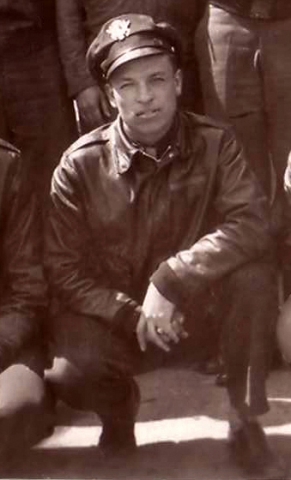
Things happened very quickly from this point on, no time really to think, but only to rely on those instincts and whatever character was hidden within each man. Lt. Wallace frantically banked and started to circle, climbing to gain more altitude so that the ship could maybe pass over just one more mountain range to the west. Yet just then the No. 4 engine faltered, then cut out completely. Fuel would be completely gone for the remaining three engines in just seconds, and that wonder of technology at that time, the efficient, high-lift Davis airfoil wing, simply would not lift even itself without those powerful engines streaming air over its upper surface. There were absolutely no more options at this point, nothing a human could do. And that other modern marvel which would have saved them just minutes before at a higher altitude—the parachute—was no longer a sure thing, as they were in fact already too low for a safe parachute jump, just 7000 feet—but over a land mass that was more than 6000 feet in elevation. Still, there was nothing else to be done, and in seconds Wallace gave the quick command to the dismayed men in the bomb bay—these young men, most just arrived in China, would have no choice but to make a terrifying and perilous jump. The plane was already starting to bank at this time, despite what the two genuine hero pilots tried in the cockpit, struggling with all their might to give the men time. In line, the men in the bomb bay each made their jumps, the first out falling into clear skies, the last out into clouds. Of course, they understood, they rushed, they tried, yet it all took precious time, and the heavy ship became almost uncontrollable as the engines failed in quick succession. Finally, with all the men out—it was just seconds later, really—Wallace ordered co-pilot Edwards to jump, while Wallace fought alone, the last man in that cockpit, to give Edwards a chance. Only after waiting for a brief time did Wallace finally give up his position, and attempt to get back to the open bomb bay. Once he let go of the controls, however, the last bit of stability was gone and the banking plane swung steeply, reeling over, making Wallace’s climb back through the radio compartment into the bomb bays a nightmare. Still, he forced himself on, finally throwing himself out through the open bomb bay door.
William H. Wallace lost his life that morning of June 10, 1944, at 25 years of age. By the time he bailed out it was too late, he was too close to the ground to survive. The seven men who parachuted out before him survived the incident because of his sacrifice, his one life redeeming seven other lives.
In my mind, Hollywood could never invent a hero as big as this common man.
I was to learn about Lt. Wallace’s loss as I researched the larger story of this crew over four years (so far) as part of the "Remembering Shared Honor" project. Using declassified US military records, along with a few photos and other clues, we searched in Yunnan province, China, for the site of the crew’s bailout the first time in January of 2003 for four days, without success, but then after more research, in early May, 2005 we were able to return and find the airplane crash site in one only day, and then find the place where Lt. Wallace died the next day—three elderly gentlemen in Qingshuitang village, Yiliang county, are still alive today who personally saw the events that morning: they describe the plane circling, the light-colored parachutes opening one by one then floating down, then that last human falling out, but his parachute never opening fully, and his "horrifying" fall, and death on the hilltop a short way behind their village. When they ran to the site, he was already dead, his partially opened chute collapsed on the ground next to him. The villagers did not know what to do, so they sent a runner to the KMT government office at the bottom of the mountain. The government staff also did not know what to do for sure, but they first sent the runner back up the mountain with instructions that the villagers protect the body at all costs. Two men from that poor village, despite their lack of education, and fears and superstitions, stayed with the body for two days and nights in ensure that neither man nor beast did him injustice. In time the KMT government and US military together made arrangements and had Lt. Wallace moved down the mountain, interring him at the temporary graveyard in Kunming. After the war in 1947 he was moved to Arlington Cemetery, but he is not there today and we have not been able to determine where he is interred now.
The other seven men landed over a surprising wide area, two making their way to the pit-side offices of the Mingliang Coal Co., and being taken care of there by the Chinese before being taken out to Camp Schiel, the American rest camp on the other side of the county. The remaining five landed on the mountain above Beiyangjie township, walked to the town and eventually were brought together there by local Chinese. One of the buildings, where they rested and ate as guests of the Chinese, is still there, and a few local people, young girls at the time, remember seeing the young Americans, and remember with light humor how the long legs of the tall men virtually dragged on the ground when they rode out on small donkeys later on the day of the crash. The survivors’ declassified report says that the Chinese who helped them usually were reluctant to take any money. When pressed, some took modest amounts, others absolutely refused.[1]
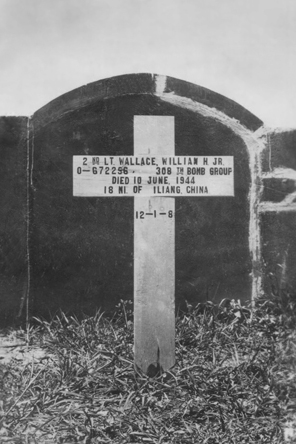
B-24 Bomber Pilot
A Young Hero
Who Knowingly Exchanged His Life
Redeeming Seven Others
June 10, 1944
Never Forgotten
February 17, 2006
Forever Remember
The Shared Sacrifices of Our Two Great Peoples
In Hope of Friendship and Peace
Why remember the loss of Lt. Wallace after so many years? Many reasons, I suppose, and maybe for each of us there the reasons might have been different. Of course, Lt. Wallace symbolizes what so many people sacrificed in those times—both American and Chinese—and this unprecedented history of mutual help between Americans and Chinese must be remembered so that it can help these two great peoples find some way to strengthen friendship today. To forget all that this earlier generation sacrificed to win for us today would be our generation’s crime. Lt. Wallace, if I may be so bold to say, is also a shared hero—a hero for the Chinese since he gave his everything to help them during their darkest days, and a hero to the Americans for his great nobility in putting his comrades first, even over his own life. For my terrific college students from America, I think they came to understand to some degree what America and China did for each other during the war, which is in itself a grand story, one they had never really heard. At the same time, for my young American college students—who are so alike the Americans who served in China during the war—I wonder if for a few short glimpses they saw themselves in that historical role, saw it not in dim black and white photos, but in its deadly seriousness and living costs. Such a glimpse could change the course of a person’s life, and I know that many of them were indeed moved by the experience.
As for me personally, it was the realization of a dream to be able to remember Lt. Wallace in such a way, someone I had dreamed about during years of research. At a minimum, we had the privilege to honor him, if only in a small way. Moreover, in some sense, we were able to approach and draw near to a hero—truthfully, how many times in life are you able to stand next to a real hero? He was indeed one such, and I, for one, will never forget my minutes in his shadow.
Patrick Lucas
[1] Since Yiliang county is right on a flight route to the several bases in the Kunming area, as might be expected, a couple other American planes went down in that same county during the war, including another B-24. In each case, the survivors were carefully attended to by the Chinese, and declassified records give much credit and appreciation to the people who helped the Americans.
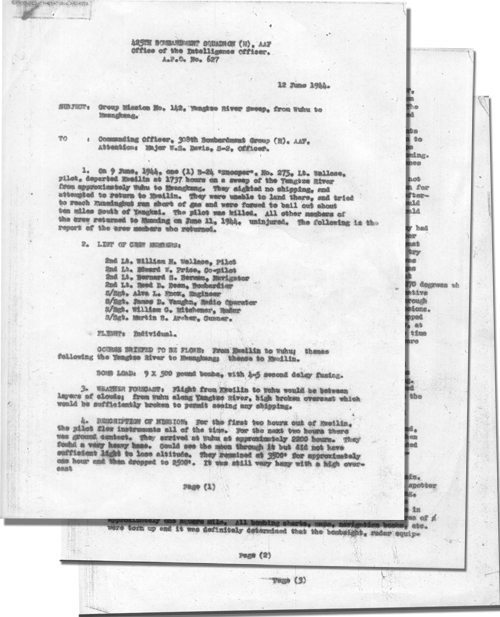
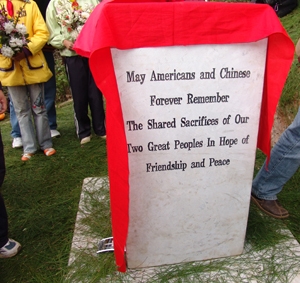


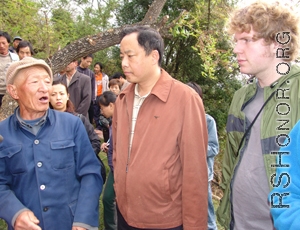
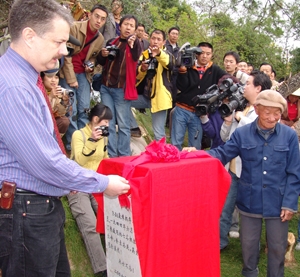
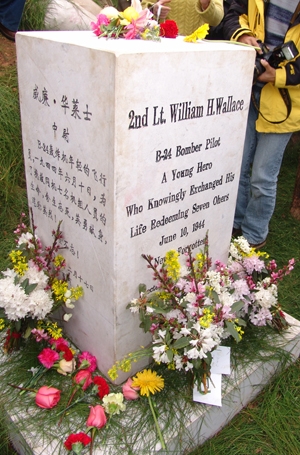
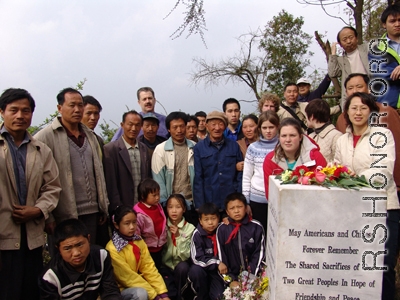


Comments
"Survived by wife, Ernestine…
"Survived by wife, Ernestine D. Wallace
Family links:
Spouse:
Ernestine Devenport Goodman (1918 - 1998)
He was the son of William H Wallace, Sr and Willie L Wallace of Dallas, TX. He graduated from Sunset High School and attended John Tarleton Agricultural College. He was working for the Sun Oil Company at the time he volunteered for the Army Air Forces in 1942.
During the war he was the pilot of a Liberator bomber and had flown ten combat missions, with his plane being credited with the sinking of an enemy vessel of considerable size.
He was killed returning from his eleventh mission while piloting B-24J #42-100275. " pat RE:William H. Wallace
"GOODMAN Ernestine Devenport, 79 yrs, Okla. City, died Mon. She was born to Ernest & Rachel (Sands) Devenport on July 27, 1918, in Dallas, TX.
Co-owner with her husband, Sandlin D. Goodman, of mobile home sales (1972-1990). She worked for the National Council on Aging & helped found the Oak Cliff Senior Citizens Center of Dallas in 1968. Her interests included cooking, sewing, calligraphy, aerobics & Senior Olympics. She also loved music, playing the piano & dancing. Loved to travel in the U.S.A. & internationally.
Survived by her daughter, Judy Ikels of Bethesda, Maryland; granddaughter, Catherine Celestino of Austin, TX; grandson, David Ernest Ikels of San Antonio, TX; sister, Florence Eckert of Los Altos, CA; nephews, Michael Eckert of Iowa City, IA, & Stephen Eckert of Boulder, CO.
Preceded in death by her parents; her first husband: Lt William Hubert Wallace, Jr who was killed in action in WWII as a B-24 Bomber Pilot; and her husband Sandlin D. Goodman (1991). Services will be 11:00 am Friday, Bill Eisenhour Southeast Chapel." pat RE:William H. Wallace